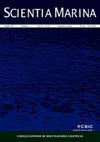Barcoding coffee grounds - Exploring pteropod gastropod biodiversity with dregs in collection jars
IF 0.9
4区 生物学
Q4 MARINE & FRESHWATER BIOLOGY
引用次数: 0
Abstract
Despite their cosmopolitan occurrence and massive plankton sampling during expeditions, the genetic diversity within Pteropoda Cuvier, 1804 is still largely unexplored. In this study we present a next-generation environmental barcoding approach to zooplankton bulk samples, which were collected during the circumglobal 2010 Malaspina expedition to evaluate pteropod diversity. We introduce a technique that avoids destructive procedures and leaves material intact for further morphological investigations. We extracted DNA out of the dregs (organic material such as mucus or body parts) of 27 sample containers for molecular barcoding (average 100-260 bp of COI). We were able to identify 7128 operational taxonomic units corresponding to the species composition contained in the examined samples. Among them were three species of thecosome pteropods, Creseis acicula, Creseis virgula and Cavolinia inflexa, which are discussed with respect to their taxonomy and their geographic distribution. Unidentified gymnosomes were also present in our samples from warmer regions in oceanic waters of the southern Indian Ocean. To facilitate identification of species, it is beneficial to create a better database of pteropod COI barcodes. Furthermore, gathering environmental barcoding data on a broad global scale will help to better understand species abundance and distribution of pteropods in the world’s oceans, and potentially those of other planktonic organisms.Barcoding咖啡渣-用收集罐中的残渣探索翼足类腹足类生物多样性
尽管它们在世界各地都有分布,在探险期间也有大量浮游生物采样,但1804年翼龙目中的遗传多样性在很大程度上仍未被探索。在这项研究中,我们提出了一种新一代的浮游动物大宗样本环境条形码方法,这些样本是在2010年马拉斯皮纳环球考察期间收集的,用于评估翼足类动物的多样性。我们介绍了一种避免破坏性程序并保持材料完整的技术,以进行进一步的形态学研究。我们从27个样品容器的残渣(有机物质,如粘液或身体部位)中提取DNA用于分子条形码(COI的平均100-260bp)。我们能够识别出7128个与所检查样本中包含的物种组成相对应的操作分类单元。其中有三种翅足类,即针尾冠蛛、盾尾冠蛛和屈折爪蛛,并对它们的分类学和地理分布进行了讨论。在我们来自南印度洋温暖海域的样本中,也存在着无法识别的裸子体。为了便于物种识别,创建一个更好的翼足类COI条形码数据库是有益的。此外,在全球范围内收集环境条形码数据将有助于更好地了解世界海洋中翼足类动物的物种丰度和分布,以及其他浮游生物的物种丰富度和分布。
本文章由计算机程序翻译,如有差异,请以英文原文为准。
求助全文
约1分钟内获得全文
求助全文
来源期刊

Scientia Marina
生物-海洋与淡水生物学
CiteScore
2.10
自引率
0.00%
发文量
21
审稿时长
6-12 weeks
期刊介绍:
Scientia Marina is the successor to Investigación Pesquera, a journal of marine sciences published since 1955 by the Institut de Ciències del Mar de Barcelona (CSIC). Scientia Marina is included in the Science Citation Index since 1998 and publishes original papers, reviews and comments concerning research in the following fields: Marine Biology and Ecology, Fisheries and Fisheries Ecology, Systematics, Faunistics and Marine Biogeography, Physical Oceanography, Chemical Oceanography, and Marine Geology. Emphasis is placed on articles of an interdisciplinary nature and of general interest.
 求助内容:
求助内容: 应助结果提醒方式:
应助结果提醒方式:


